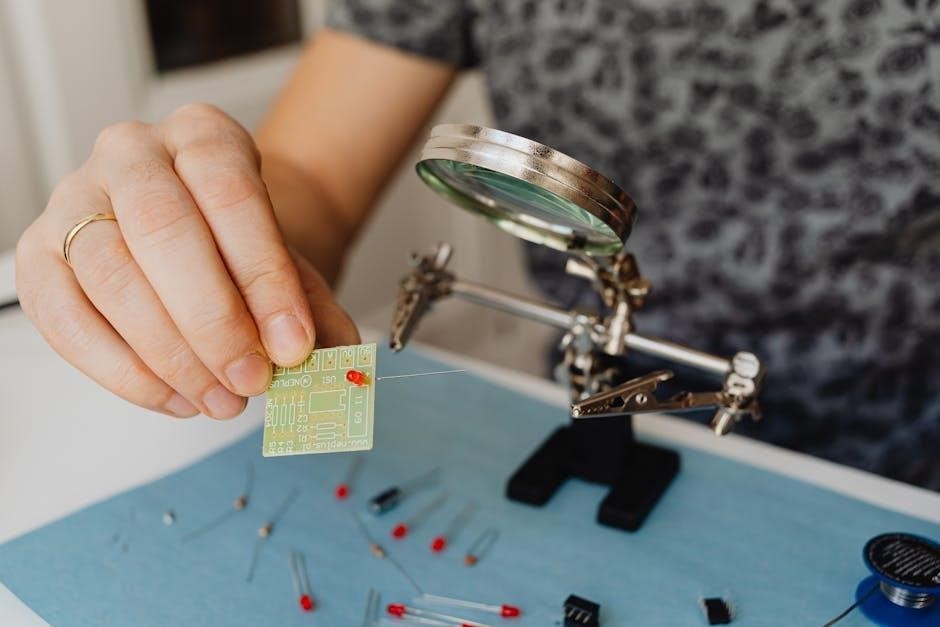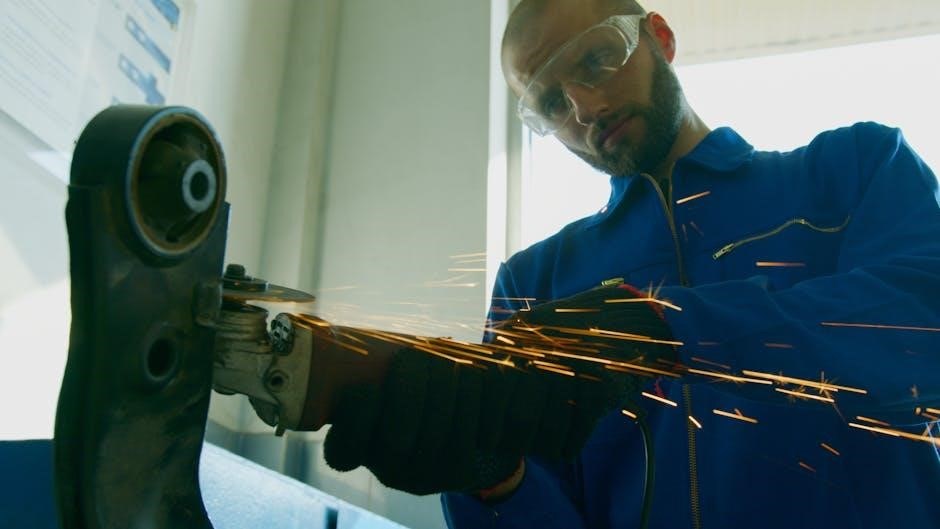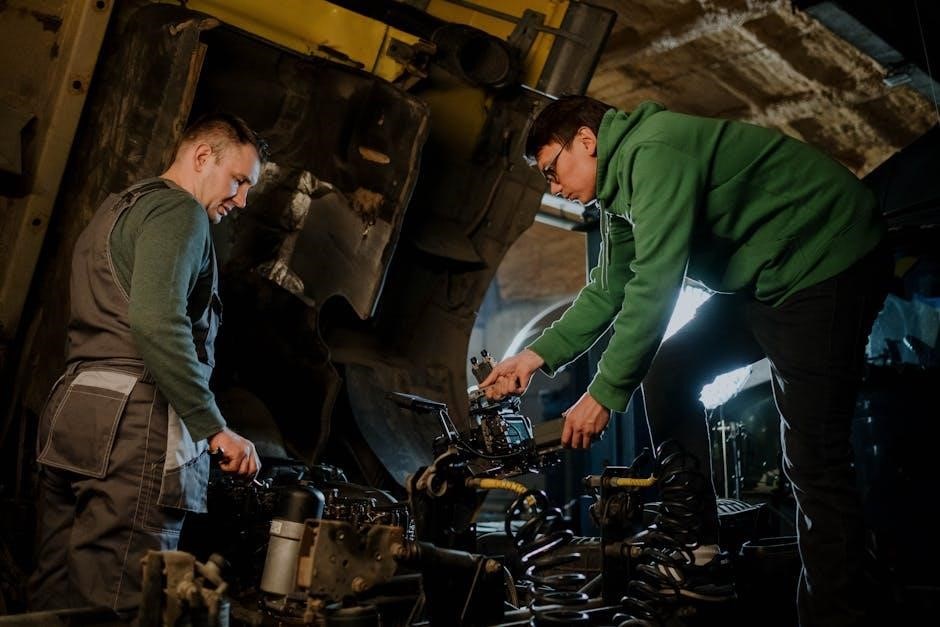GE Washing Machine Repair Manual: A Comprehensive Guide
Is your GE washing machine giving you trouble? This comprehensive guide offers solutions to common GE washer issues․ Whether it’s a top load (GTW), front load (WCV), stackable (GFW), or portable (GNW) model, this manual provides troubleshooting steps, repair information, and essential maintenance tips to restore your machine’s performance․
Welcome to the world of GE washing machine repair! This section provides a foundational understanding of the common problems encountered in GE washers and empowers you to address them effectively․ GE, a trusted name in home appliances, offers a range of washing machines, including top-load, front-load, and portable models․ However, like any appliance, GE washers can experience issues over time․ This introduction aims to equip you with the knowledge and resources needed to diagnose and resolve these problems․
Whether your GE washer won’t start, isn’t spinning correctly, has drainage problems, or is slow to fill, understanding the basic principles of repair is essential․ This guide will walk you through identifying the root cause of the issue and provide step-by-step instructions for fixing it․ We will also cover the necessary tools and safety precautions to ensure a successful repair․
From replacing a faulty lid switch to changing the belt, this manual covers a wide range of repair procedures․ You’ll also learn about GE repair and care plans and discover valuable maintenance tips to prolong the life of your washing machine․ By following this comprehensive guide, you can save money on repair costs and keep your GE washer running smoothly for years to come․
Common GE Washing Machine Problems
GE washing machines, while reliable, are susceptible to certain common issues that can disrupt your laundry routine․ One frequent problem is a washing machine that won’t start․ This could be due to a faulty lid switch, a blown fuse, or a problem with the motor․ Diagnosing the exact cause is crucial for effective repair․
Spinning problems are another common complaint․ If your GE washer isn’t spinning correctly, it could be caused by a worn-out drive belt, a malfunctioning motor capacitor, or a faulty motor․ Drainage issues are also prevalent, often resulting from a clogged drain pump or a blocked drain hose․ Addressing these blockages promptly can prevent further damage․
Slow-filling washing machines can also be a source of frustration; This may be due to a clogged water inlet valve or low water pressure․ A faulty water sensor can also cause filling problems․ In addition to these issues, problems with the lid switch and wire harness can also occur․ Understanding these common problems is the first step toward effective troubleshooting and repair, ensuring your GE washing machine operates smoothly․
Essential Tools for GE Washing Machine Repair
Before embarking on GE washing machine repairs, assembling the right tools is paramount for efficiency and safety․ A basic toolkit should include a set of screwdrivers, both Phillips head and flathead, in various sizes․ These are essential for disassembling and reassembling components during repairs․ Pliers, including needle-nose pliers, are useful for gripping and manipulating small parts and wires․
A multimeter is indispensable for electrical troubleshooting․ It allows you to test voltage, continuity, and resistance, helping you identify faulty components like switches, motors, and capacitors․ A socket set and wrenches are needed for removing and tightening bolts and nuts that secure various parts of the washing machine․ A specialized tool, such as a spanner wrench, might be required for specific tasks like removing the inner tub․
For safety, always wear work gloves to protect your hands from sharp edges and electrical shock․ Eye protection, like safety glasses, is also crucial․ Additionally, have a container ready to catch any water that may spill during the repair process․ With these essential tools at your disposal, you’ll be well-equipped to tackle most GE washing machine repairs effectively and safely․
Troubleshooting a GE Washing Machine That Won’t Start
A GE washing machine that refuses to start can be frustrating, but often the issue can be diagnosed and resolved with a systematic approach․ Begin by verifying the power supply․ Ensure the machine is properly plugged into a functioning outlet․ Check the circuit breaker or fuse box to rule out any tripped breakers or blown fuses that may be interrupting power to the appliance․
Next, examine the lid switch or door latch․ GE washers are designed with a safety mechanism that prevents operation if the lid or door is not securely closed․ A faulty lid switch or door latch can prevent the machine from starting․ Use a multimeter to test the continuity of the lid switch․ If it shows no continuity when the lid is closed, the switch may need replacement․
Another potential culprit is the timer or control panel․ If the timer is not advancing or the control panel is unresponsive, it could indicate a malfunction․ Inspect the wiring connections to the timer or control panel for any loose or damaged wires․ If the wiring appears intact, the timer or control panel itself may need to be replaced․ Finally, consult your GE washing machine’s user manual for specific troubleshooting steps and error codes that may help pinpoint the problem․
Diagnosing and Repairing Spinning Issues
A GE washing machine that struggles to spin clothes dry can be a significant inconvenience․ Several factors could contribute to this issue, requiring a methodical approach to diagnose and repair․ Start by checking the lid switch or door lock․ Many GE washers won’t spin if the lid or door isn’t properly closed․ A faulty switch prevents the motor from engaging the spin cycle․ Test the switch for continuity using a multimeter․ If it fails the test, replacement is necessary․

Examine the drive belt for wear and tear․ Over time, the belt can stretch, crack, or break, leading to inadequate power transfer to the spin mechanism․ A worn belt should be replaced with a new one of the correct size and specification․ Next, investigate the motor capacitor․ This component provides the initial surge of power needed to start the motor․ A failing capacitor can weaken the motor’s ability to spin effectively․ A multimeter can be used to test the capacitor’s functionality․
Finally, consider the motor itself․ A worn-out or damaged motor may struggle to generate the necessary torque for spinning․ Listen for unusual noises during the spin cycle, such as grinding or squealing, which could indicate motor problems․ If all other components appear to be functioning correctly, the motor may need professional evaluation or replacement․
Addressing Drainage Problems in GE Washers
A GE washing machine that fails to drain properly can lead to messy and frustrating situations․ Several components play a crucial role in the drainage process, and identifying the source of the blockage is key to resolving the issue․ The most common culprit is a clogged drain hose․ Disconnect the hose from both the washer and the drainpipe, and inspect it for obstructions such as lint, small objects, or soap residue․ Flush the hose with water to remove any debris․
Next, examine the drain pump filter․ This filter is designed to trap lint and other particles before they reach the drain pump, preventing damage․ Locate the filter, typically at the front or rear of the washer, and remove it․ Clean the filter thoroughly, removing any accumulated debris․ A clogged filter restricts water flow and hinders drainage efficiency․ If the filter is damaged, replace it with a new one․
If the drain hose and filter are clear, the drain pump itself may be faulty․ The pump is responsible for actively expelling water from the washer․ Listen for a humming or buzzing sound during the drain cycle, which could indicate a malfunctioning pump․ Use a multimeter to test the pump’s continuity․ If the pump fails the test, replace it․ Also check for any kinks in the drain hose that may be restricting water flow․
Fixing a Slow-Filling Washing Machine
A washing machine that takes an excessively long time to fill can disrupt your laundry routine and potentially damage your appliance․ Several factors can contribute to this issue, and a systematic approach is essential for effective troubleshooting․ First, verify that both the hot and cold water supply valves are fully open․ Partially closed valves restrict water flow, leading to slow filling․ Check the water pressure in your home to ensure it meets the washing machine’s requirements․ Low water pressure can significantly impact filling speed․
Next, inspect the water inlet hoses for kinks or blockages․ Kinks restrict water flow, while debris accumulation can clog the hoses․ Disconnect the hoses from both the water supply and the washing machine, and examine them for any obstructions․ Flush the hoses with water to remove any sediment or debris․ If the hoses are damaged, replace them with new ones․
The water inlet valve, located at the back of the washing machine, controls the flow of water into the tub․ A faulty valve can restrict water flow, resulting in slow filling․ Use a multimeter to test the valve’s solenoid․ If the solenoid is defective, replace the water inlet valve․ Lastly, check the screen filters located at the inlet valve connections․ These filters trap sediment and debris, preventing them from entering the washing machine․ Clean or replace the filters as needed to ensure optimal water flow․
Replacing the Lid Switch and Wire Harness
The lid switch is a crucial safety component in your GE washing machine, preventing operation when the lid is open․ A faulty lid switch can cause the washer to not start, stop mid-cycle, or display error codes․ Similarly, a damaged wire harness connecting the lid switch can disrupt its functionality․ Replacing both the lid switch and wire harness is a relatively straightforward repair that can restore your washer’s proper operation․
Before starting, disconnect the washing machine from the power source to prevent electrical shock․ Locate the lid switch, typically positioned under the lid or near the door frame․ Use a screwdriver to remove the screws securing the lid switch cover․ Carefully disconnect the wire harness from the lid switch․ Note the wire connections or take a photo for reference during reassembly․
Remove the old lid switch and install the new one, ensuring it is properly aligned․ Connect the new wire harness to the new lid switch, matching the wire connections to the original configuration․ Secure the lid switch cover with screws․ Test the washing machine to verify that the new lid switch and wire harness are functioning correctly․ If the washer still doesn’t operate, double-check the wire connections and consult the troubleshooting section for further assistance․
Changing the Belt on Your Washing Machine
A worn or broken belt can prevent your GE washing machine from spinning or agitating properly․ Over time, the belt can stretch, crack, or break, leading to reduced performance or complete failure․ Replacing the belt is a common repair that can restore your washer’s functionality․ This task is manageable for a DIY enthusiast with basic tools and guidance․
First, disconnect the washing machine from the power outlet and turn off the water supply; Access the belt, typically located at the rear or underside of the washer․ You may need to remove an access panel or the entire cabinet to reach the belt; Carefully inspect the belt for signs of wear, such as cracks or fraying․ If the belt is broken, remove the remnants from the pulleys․
To install the new belt, loop it around the motor pulley and the tub pulley․ Ensure the belt is properly seated in the grooves of both pulleys․ The belt should be snug but not overly tight․ Rotate the pulleys by hand to ensure the belt is properly aligned and moving smoothly․ Reassemble any access panels or the cabinet that you removed․ Reconnect the water supply and plug the washing machine back into the power outlet․ Run a test cycle to confirm that the new belt is functioning correctly, and the washer is spinning and agitating as expected․

Finding GE Appliance Repair Services
When your GE washing machine needs professional attention, locating reliable repair services is crucial․ Several options are available, ranging from authorized GE service providers to independent appliance repair technicians․ GE Appliances are proudly serviced by Bodewell, previously known as GE Factory Service, ensuring expertise and genuine parts․ Mr․ Appliance is another reputable service provider with certified professionals experienced in GE appliance repairs․
To find local repair services, start by checking the GE Appliances website for authorized service centers in your area․ Online directories like Yelp can provide reviews and ratings of local appliance repair companies․ Consider factors such as experience, certifications (like TSSA for gas appliances), and customer reviews when selecting a repair service․

For urgent repairs, look for companies offering same-day or next-day service․ Be wary of callout charges that are payable even if the washing machine cannot be fixed․ Some companies offer repair and care plans that may cover multiple repairs for a set fee․ Contact several service providers to compare quotes and ensure they have experience with GE washing machines․ A qualified technician can accurately diagnose the issue, source the correct parts, and complete the repair efficiently, restoring your washing machine to proper working order․
Understanding GE Repair and Care Plans
GE offers Repair and Care plans as an alternative to single repairs․ These plans can provide cost savings and peace of mind by covering multiple repairs over a specified period․ Single repairs may involve a callout charge, even if the washing machine cannot be fixed, making a care plan a potentially more economical option for frequent issues or older machines․

Before opting for a Repair and Care plan, carefully review the terms and conditions․ Understand what is covered, including specific parts and labor costs․ Determine the plan’s duration and any limitations on the number of repairs․ Compare the cost of the plan to the potential cost of individual repairs, considering the average washing machine repair cost can range from $200 to $265․
Consider the age and condition of your GE washing machine․ If it’s an older model prone to breakdowns, a Repair and Care plan might be a worthwhile investment․ However, for newer machines with fewer potential issues, single repairs may be more cost-effective․ Factor in the convenience and peace of mind that a comprehensive plan offers, knowing that you’re covered for unexpected breakdowns․ By carefully evaluating your needs and the plan’s details, you can make an informed decision about whether a GE Repair and Care plan is the right choice for you․
GE Washing Machine Maintenance Tips
Proper maintenance is key to extending the life of your GE washing machine and preventing costly repairs․ Regularly clean the dispenser drawers to prevent detergent buildup, which can lead to clogs and reduced cleaning effectiveness․ Inspect hoses for cracks or leaks, replacing them as needed to avoid water damage․
Clean the washing machine’s interior regularly by running an empty cycle with a washing machine cleaner or a mixture of vinegar and baking soda․ This helps eliminate odors and prevent mold growth․ Check the lint filter frequently and remove any accumulated lint to ensure proper drainage and prevent clogs․ Avoid overloading the washing machine, as this can strain the motor and other components․
Level the washing machine to prevent excessive vibration and noise during operation․ Periodically inspect the washing machine’s belts for wear and tear, replacing them if necessary․ If you notice any unusual noises or performance issues, address them promptly to prevent further damage․ By following these simple maintenance tips, you can keep your GE washing machine running smoothly and efficiently for years to come, minimizing the need for repairs and maximizing its lifespan․

